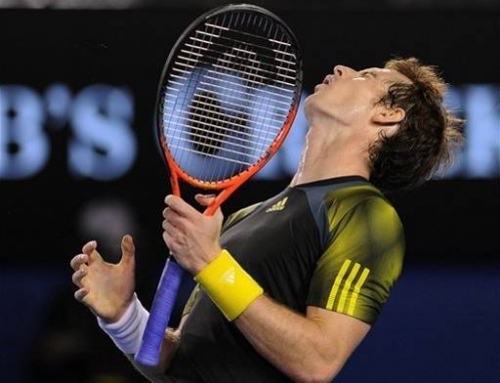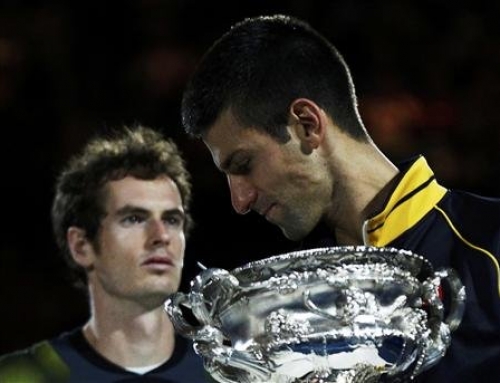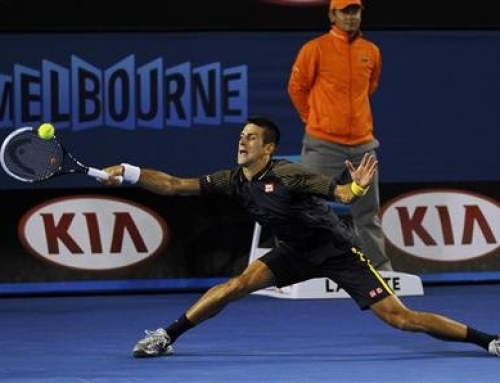 Day 6 saw the top men in a game of one-ups-manship. Anything you can do, I can do better.
Day 6 saw the top men in a game of one-ups-manship. Anything you can do, I can do better.
Roger Federer played 31st seed Albert Montanes. Montanes is a veteran of the tour having played for a little over 10 years. Perhaps like Ivo Karlovic, Montanes is playing some of his best tennis ever. Sure, it’s tough to talk about a player ranked out of the top 20 having a “best year”, but it does happen. The sport isn’t just the top 20 players.
Ranked 31, Montanes earned a seed, and his best rank of 28, happened last year just before the French.
This is a match that Federer would say he felt comfortable with because he won. He would point out that he never faced break point, thus never lost serve, and how important that is. Yet, he won 6-3, 6-4, 6-4. He didn’t get on the roll he did against Victor Hanescu (another tour veteran) where he hit a great number of winners to very few errors. There, he had roughly 50 winners to 20 unforced errors. In this match, he had 39 unforced errors to 36 winners, committing twice as many errors to maybe 70% winners. Federer found himself making more errors than he wanted to against a player that was solid but wasn’t about to threaten him.
Nikolay Davydenko also played a clay courter ranked about 30. Except his opponent was Juan Monaco, the up and coming player from Argentina. For a while, Davydenko looked like he would humiliate Monaco. A set had gone by and Davydenko was not only holding serve early but also breaking easily, often at triple break point. Monaco couldn’t keep the ball in play and looked much worse than his 33rd rank would indicate. There was some suggestion that maybe he’d win love, love, and love, but that a player as good as Monaco shouldn’t lose that easily.
Eventually, Monaco did start to win games. Part of it was simply getting his game in shape and part of it was Davydenko making a few more errors. The stat line tells an interesting story. Davydenko hit 30 unforced errors to 22 winners. Compare this to Federer. Davydenko hit 9 fewer unforced errors but also hit 14 fewer winners in a straight set win.
Davydenko’s style of play is not purely angles. To complement the way he plays, he also goes to an unusual source–Viv Braden. Davydenko may never have heard of the tennis teacher most known for “smiling to win”. Braden thought that some people overrated strategy, thinking that most pros had complex diagrams much like an offensive coordinator’s playbook. Braden said “hit the ball up the middle and deep”.
Davydenko isn’t all about generating the angles and although Monaco hit his shots far behind the baseline (except when he realized this was getting him into trouble) and is thus vulnerable to the sharp angles by the baseline-hugging player, Davydenko hit many shots up the middle, playing neutral shot after neutral shot, perhaps baiting Monaco to go for the angles.
Final score: 6-0, 6-3, 6-4. Davydenko now plays Fernando Verdasco. Given the two styles of play, one might imagine it would be a tough call. Davydenko’s speed and consistency. Verdasco’s hard hitting style. And yet, Davydenko leads this head-to-head 6-1 including 2 wins in 2009 after Verdasco’s great Australian Open run. Davydenko’s style seems to rob Verdasco of time to hit and this leads him to more errors than he normally hits.
Of the top players, however, Novak Djokovic played the cleanest tennis in his straight set win. Critics would say he played someone ranked 103 while both Federer and Davydenko played players ranked in the 30s. Denis Istomin, of Uzbekistan, aged 23, has had a career high rank of 57. Darren Cahill commented that Roger Federer has practiced with Istomin, perhaps one of the many players Roger invites to play with him, and says the man is a very hard worker and to expect him to do well, though mature late. Istomin did reach the fourth round without having dropped a set. He beat 32 seed, Jeremy Chardy, 6-2, 6-2, 6-0 in the first round and Michael Berrer of Germany, 7-5, 6-3, 6-4.
But he picked the wrong day to face Novak Djokovic. Djokovic had just come off a match against the third best Swiss player and childhood friend of Roger Federer, Marco Chiudinelli, looking like he won in sleep-walk. He needed to straighten up his game and show that he is a serious contender to win the Australian Open.
Although the final scores showed, 6-1, 6-1, 6-2, Djokovic was on the verge of winning this at love in every set, having a small mental lapse in each set including getting broken late in the 3rd set. One of Djokovic’s coaches, Todd Martin, had been advising Novak to approach the net more and be more aggressive. It seemed like Djokovic channeled all this advice into one match. Not only that, Djokovic decided to test Istomin’s movement, and trotted out the drop shot like it was going out of style.
Time and again, Djokovic would either initiate the drop shot or return a drop off a drop when Istomin felt the need to drop. Istomin would rush to the net, try to hit a pass, and typically, Djokovic would hit to the open court. Djokovic’s newfound aggression is tempered a bit by the quality of his volley. Today’s modern volleyers learn the drop volley first. With such great passers playing today, the way to win a point at net is to avoid having opponent’s hit a second pass. The one drawback of this approach is a lack of solid punch on volleys that should be punched, and players like Djokovic don’t hit the standard volley crisply. Even so, the aggression still paid off.
A few players had easy matches only because their opponents retired or didn’t even show up. Lukasz Kubot had a walkover over Mikhail Youzhny. This was a bit odd since Youzhny had a straight set win in the 2nd round, although he was forced to go 5 sets in the first round against Richard Gasquet in the first round. He hurt his wrist, and pulled out prior to the match. Fernando Verdasco had to get on court. Even before his 6-1 win in the first set, announcers were noticing that Koubek didn’t look like he’d finish the match. Koubek was trying to play through a fever, but ultimately decided he wasn’t feeling well enough to complete the match.
Nicolas Almagro, the 26th seed, had a comfortable straight set win over Alejandro Falla of Colombia, 6-4, 6-3, 6-4.
The interesting matches were in the evening, but even they didn’t quite live to billing. The hugely talented Jo-Wilfried Tsonga, who was a finalist at the Australian Open in 2008, beat Wimbledon semifinalist, Tommy Haas, 6-4, 3-6, 6-1, 7-5.
Finally, in perhaps the most expected match of the day, Lleyton Hewitt played Marcos Baghdatis. Hewitt knew Baghdatis had played a tough five setter, and wanted to be aggressive against the Cypriot, get him on his heels. After a 6-0, 4-2 lead, Baghdatis said no more and retired complaining about his arm saying he couldn’t hit the shot well and felt as if he were pushing the ball the whole time.
Hewitt’s reward for this win is the usual. Another meeting with Roger Federer. Hewitt said that Roger is great, but that he did a few things to bother Federer when they met at the US Open. He felt he needed to be aggressive, take the game to Roger, because Roger, when he’s in a rhythm, can be very hard to beat.
As we head into Day 7, the matches become fewer and all of them involve high ranked players. On the main court, Andy Murray takes on the other hot player of the day, John Isner. Murray has had pretty good luck playing big servers. Although he’s never played Isner, his combined record against Karlovic and Sam Querrey is 6-0, with 3 wins apiece. Isner will certainly be an underdog in this match, and it will be interesting to see what Isner can bring to the table against someone that plays the big serve so well.
Speaking of big servers, Ivo Karlovic plays Rafael Nadal. Nadal said, in a post-match interview, that he needed to protect his own serve, because Karlovic can make life tough for most receivers. Karlovic’s serve is so big that serving and volleying makes sense to him. Returners often bloop returns back leading to an easy volley. Karlovic’s game has actually improved as he’s gotten older. He always has his serve, but his forehand has gotten sufficiently big that you can’t just beat him by getting the ball back over the net. Even so, Nadal is likely to win this. Karlovic would have to be zoning to win.
Andy Roddick plays Fernando Gonzalez. He has a 8-3 head-to-head. Surprisingly, Roddick tends to play Gonzalez quite well. In the matches he wins, he often wins easily. I suspect, much like the Lopez match, Roddick will have his hands full with Gonzalez, but will ultimately prevail.
In a replay of the US Open, Marin Cilic plays Juan Martin del Potro once again. It’s difficult to predict how the wrist is affecting del Potro. It’s not affecting him so much that del Potro is losing, and yet, he’s not winning as easily as he sometimes does. This match should really be a bellwether for del Potro’s game. Is del Potro’s mental game good enough to get him past Cilic? Is Cilic ready to take his game to the next level?
People have touted Cilic to make a big leap, but it’s possible Cilic may not be paying attention to this talk which only those who seriously watch tennis have heard of.
Heading into week two, we’re going to see who has the game to win it all.






![[Aussie Open Final] Can Andy Murray beat Novak Djokovic?](https://www.essentialtennis.com/wp-content/uploads/2013/01/20130126andy-500x383.jpg)
![[Day 13, Aussie Open] Bryan brothers win 13th Slam with Aussie doubles title, Kyrgios wins boys title](https://www.essentialtennis.com/wp-content/uploads/2013/01/20130125bryan-500x383.jpg)